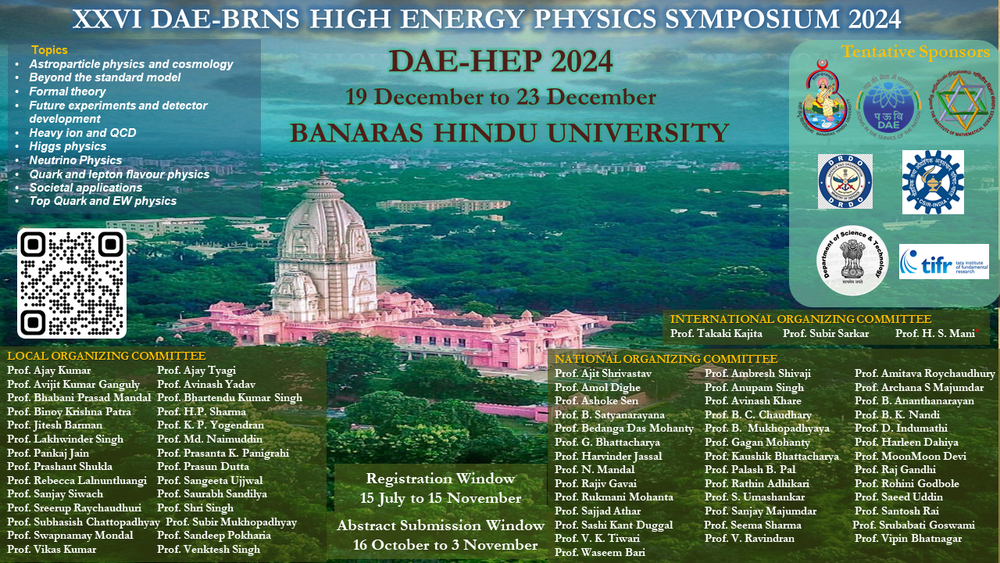Speaker
Description
Particle–antiparticle pair creation from a vacuum under the action of a strong electromagnetic(EM) field is one of the most profound phenomena in quantum electrodynamics (QED). The phenomenon of pair creation can be seen as a field-induced phase transition (FIPT) [1,5]. This occurs because the vacuum state evolves over time due to the non-stationary Hamiltonian [7], leading to spontaneous symmetry breaking under time reversal. As a result, electron-positron pairs are generated, acting as massive analogs of Goldstone bosons [2,3].To measure this symmetry breaking, we define a complex order parameter, Φ(p, t), given by Φ(p, t) = 2⟨0in|a† p(t)b† −p(t)|0in⟩ = |Φ(p, t)| exp(iψ(p, t)), where a† p(t) and b† −p(t) are operators that create particles and antiparticles with momentum ±p in a time-dependent basis [1,4-6].FIPT has been explored in oscillating electric fields with a Gaussian profile and Sauter pulse profile [4-5]. The modulus of the order parameter, |Φ(p, t)|, evolves through three stages: the quasi-electron-positron plasma (QEPP) stage, the transient stage, and the residual electron-positron plasma (REPP) stage[4,6]. However, the evolution of the complex order parameter in a sequence of Sauter pulses with time delay T remains unstudied.
In this work, we employ the quasi-particle representation of quantum kinetic theory (QKE) to investigate the evolution of the vacuum state in a time-dependent electric field [1,8-10]. Using the mean-field approximation—neglecting collisions and back-reaction on the external field—we examine the modified evolution stages of the order parameter, which transitions from quasielectron-positron plasma oscillations to the residual electron-positron plasma stage via the highly non-linear transient region[8,9].
Additionally, we study the evolution of entropy for a sequence of laser pulses with time delay, revealing that entropy density evolution aligns with the modulus of the order parameter in the quasi-particle stage of the single-particle distribution function’s dynamical evolution. This correspondence implies a non-monotonic increase in entropy as vacuum breakdown occurs. Instantaneous entropy increases or decreases reflect the interplay between polarizing and depolarizing effects given by the real and imaginary components of the order parameter, governing the dynamics of pair production and annihilation. The monotonic increase in entropy beyond the transient region is attributed to the dephasing in the particle-antiparticle correlation function.
References
1. D. B. Blaschke, A. V. Prozorkevich, G. R¨opke, C. D. Roberts, S. M. Schmidt, D. S. Shkirmanov, and S. A. Smolyansky, Eur. Phys. J. D 55, 341 (2009).
2. A. A. Grib, S. G. Mamaev and V. M. Mostepanenko. Friedmann Laboratory Publishing,
St. Petersburg, 1994.
3. S. Coleman. J. Math. Phys. 7, 787 (1966).
4. S. A. Smolyansky et al., Ultrametric Anal. Appl. 4, 319 (2012).
5. S. A. Smolyansky, A. D. Panferov, D. B. Blaschke, L. Juchnowski, B.K¨ampfer, and A. Otto,
Russ. Phys. J. 59, 1731 (2017).
6. C. Banerjee and M. P. Singh, Phys. Rev. D 100, 056016 (2019).
7. A. Alvarez-Dom´ınguez, L. J. Garay, D. Garc´ıa-Heredia, ´ and M. Mart´ın-Benito, JHEP
2021, 74 (2021).
8. C. Banerjee and M. P. Singh, Phys. Rev. D 105 (2022) no.7, 076021 [arXiv:1807.06951
[physics.plasm-ph]].
9. D. Sah and M. P. Singh, Springer Proc. Phys. 304 (2024), 1023-1025 doi:10.1007/978-981-
97-0289-3 275.
10. D. Sah and M. P. Singh,[arXiv:2309.12079 [hep-ph]].
| Field of contribution | Phenomenology |
|---|

